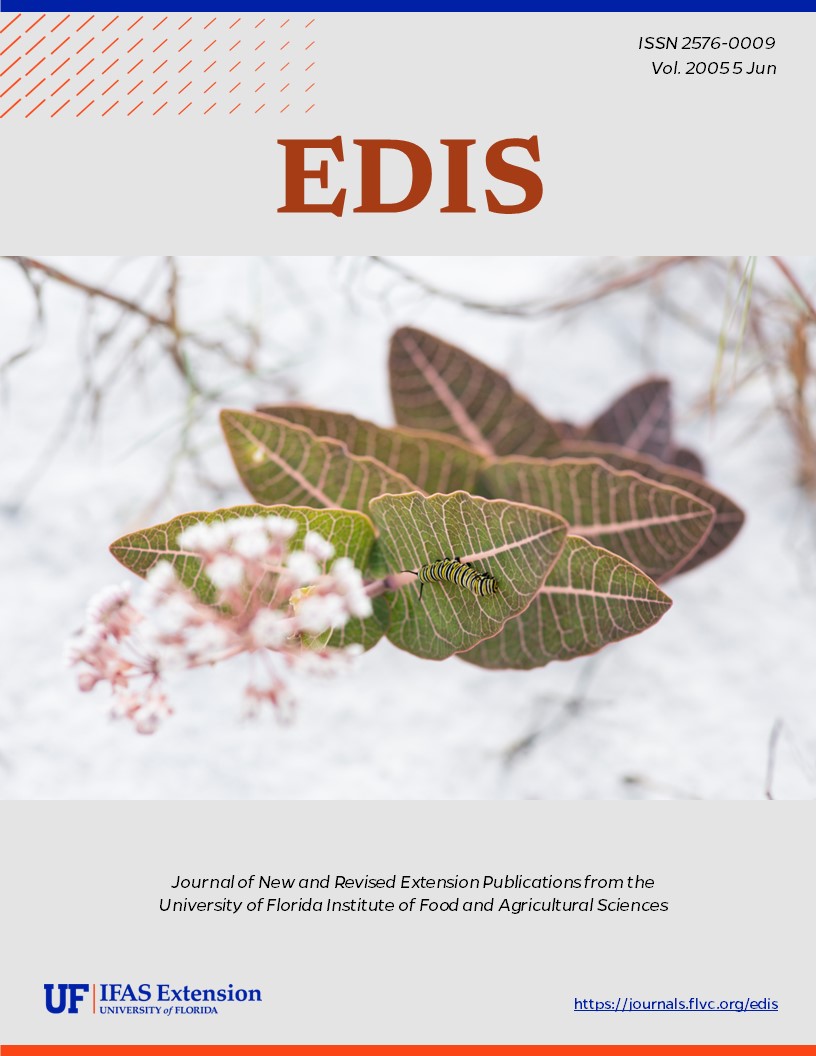Abstract
The tetrio sphinx, Pseudosphinx tetrio (Linnaeus), is a common moth in the American tropics and subtropics that less frequently occurs in southern parts of Florida. Although the adults exhibit mostly drab grey coloration, larvae are conspicuous, large caterpillars that often occur in gardens feeding on frangipani and other members of the dogbane family (Apocynaceae). This document is EENY-344, one of a series of Featured Creatures from the Entomology and Nematology Department, Florida Cooperative Extension Service, Institute of Food and Agricultural Sciences, University of Florida. Published: March 2005.
References
Brown CH. 1976. A survey of the Sphingidae of Sanibel Island, Florida. Journal of the Lepidopterists' Society 30: 230-233.
Burmeister H. 1855. Abhandl. Naturforschende Ges. zu Halle, 3, Sitzungsberichte. p. 65.
Burmeister H. 1856. Abhandl. Naturforschende Ges. zu Halle, 3, Sitzungsberichte. p. 68.
Butler AG. 1877. Revision of the heterocerous Lepidoptera of the family Sphingidae. Transactions of the Zoological Society of London 9: 610. https://doi.org/10.5962/bhl.title.62142
Cramer P. 1780. De Uitlandsche Kapellen Voorkomende en Drie Waereld-Deelen Asia, Africa en America. Amsterdam. p. 175. https://doi.org/10.5962/bhl.title.65748
Fabricius JC. 1775. Systema Entomologiae sistens Insectorum Classes, Ordines, Genera, species, Adiectis Synonymis, Locis, Descriptionibus, Observationibus. Leipzig. 832 pp. https://doi.org/10.5962/bhl.title.36510
Gabel K. (2003). Frangipani. Key West: UF/IFAS Monroe County Extension Service. http://monroe.ifas.ufl.edu/aug03_frangipani.htm (2 February 2005).
Gribel R, Hay JD. 1993. Pollination ecology of Caryocar brasiliense (Caryocaraceae) in Central Brazil cerrado vegetation. Journal of Tropical Ecology 9: 199-211. https://doi.org/10.1017/S0266467400007173
Heppner JB. 2003. Lepidoptera of Florida. Arthropods of Florida and Neighboring Land Areas Vol. 17. Florida Department of Agriculture and Consumer Services, Division of Plant Industry, Gainesville, FL.
Hodges RW. 1971. Sphingoidea: Hawkmoths. The Moths of America North of Mexico, Fascicle 21, EW. Classey Limited, Middlesex, England and RBD. Publications, Inc., Washington, D.C. 158 pp., 14 pls., and v-xii pp.
Jahnes BC, Hyland EM, Needham K, Brumwell L, Rodriguez E. (2002). The chemical ecology of three species of Lepidoptera and their hostplants on the Cornell Esbaran Preserve, Yarapa River Peru. Emanations 4. 3 pp. http://labs.plantbio.cornell.edu/cubl/emanv4.html (1 February 2005).
Janzen DH. 1980. Two potential coral snake mimics in a tropical deciduous forest. Biotropica 12: 77-78 https://doi.org/10.2307/2387778
Linnaeus C. 1771. Mantissa Plantarum Altera. Stockholm. p. 538.
Lucas PH. 1857. Ordre des Lepidoptères. In Ramon de la Sagra, Histoire physique, politique et naturelle de l'île de Cuba 7: 474-750.
Meerman JC. (2002). The annual outbreak of colorful caterpillars of the frangipani hawkmoth (Pseudosphinx tetrio). Biological-Diversity.info. http://biological-diversity.info/pseudosphinx.htm (25 January 2005).
Merle H, Suchocki D, Gerard M, Donnio A. 2001. Keratitis due to caterpillar of Pseudosphinx tetrio hairs. Journal français d'ophtalmologie 24: 635-639.
Minno MC, Darrow HN. 1995. Pseudosphinx tetrio (L.) (Lepidoptera: Sphingidae) in the Florida Keys. News of the Lepidopterists' Society 1: 5-6.
Morton JF, Ledin RB. 1952. 400 Plants of South Florida. Text House, Inc. Coral Gables, Florida. 134 pp.
Santiago-Blay JA. 1985. Notes on Pseudosphinx tetrio (L.) (Sphingidae) in Puerto Rico. Journal of the Lepidopterists' Society 39: 208-214.
Walker F. 1856. List of Specimens of Lepidopterous Insects in the Collection of the British Museum. London. 8: p. 198.

